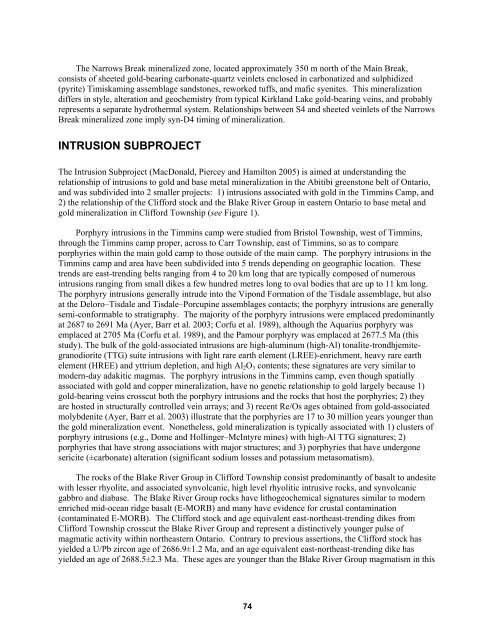Overview of Results from the Greenstone ... - Geology Ontario
Overview of Results from the Greenstone ... - Geology Ontario
Overview of Results from the Greenstone ... - Geology Ontario
Create successful ePaper yourself
Turn your PDF publications into a flip-book with our unique Google optimized e-Paper software.
The Narrows Break mineralized zone, located approximately 350 m north <strong>of</strong> <strong>the</strong> Main Break,<br />
consists <strong>of</strong> sheeted gold-bearing carbonate-quartz veinlets enclosed in carbonatized and sulphidized<br />
(pyrite) Timiskaming assemblage sandstones, reworked tuffs, and mafic syenites. This mineralization<br />
differs in style, alteration and geochemistry <strong>from</strong> typical Kirkland Lake gold-bearing veins, and probably<br />
represents a separate hydro<strong>the</strong>rmal system. Relationships between S4 and sheeted veinlets <strong>of</strong> <strong>the</strong> Narrows<br />
Break mineralized zone imply syn-D4 timing <strong>of</strong> mineralization.<br />
INTRUSION SUBPROJECT<br />
The Intrusion Subproject (MacDonald, Piercey and Hamilton 2005) is aimed at understanding <strong>the</strong><br />
relationship <strong>of</strong> intrusions to gold and base metal mineralization in <strong>the</strong> Abitibi greenstone belt <strong>of</strong> <strong>Ontario</strong>,<br />
and was subdivided into 2 smaller projects: 1) intrusions associated with gold in <strong>the</strong> Timmins Camp, and<br />
2) <strong>the</strong> relationship <strong>of</strong> <strong>the</strong> Clifford stock and <strong>the</strong> Blake River Group in eastern <strong>Ontario</strong> to base metal and<br />
gold mineralization in Clifford Township (see Figure 1).<br />
Porphyry intrusions in <strong>the</strong> Timmins camp were studied <strong>from</strong> Bristol Township, west <strong>of</strong> Timmins,<br />
through <strong>the</strong> Timmins camp proper, across to Carr Township, east <strong>of</strong> Timmins, so as to compare<br />
porphyries within <strong>the</strong> main gold camp to those outside <strong>of</strong> <strong>the</strong> main camp. The porphyry intrusions in <strong>the</strong><br />
Timmins camp and area have been subdivided into 5 trends depending on geographic location. These<br />
trends are east-trending belts ranging <strong>from</strong> 4 to 20 km long that are typically composed <strong>of</strong> numerous<br />
intrusions ranging <strong>from</strong> small dikes a few hundred metres long to oval bodies that are up to 11 km long.<br />
The porphyry intrusions generally intrude into <strong>the</strong> Vipond Formation <strong>of</strong> <strong>the</strong> Tisdale assemblage, but also<br />
at <strong>the</strong> Deloro–Tisdale and Tisdale–Porcupine assemblages contacts; <strong>the</strong> porphyry intrusions are generally<br />
semi-conformable to stratigraphy. The majority <strong>of</strong> <strong>the</strong> porphyry intrusions were emplaced predominantly<br />
at 2687 to 2691 Ma (Ayer, Barr et al. 2003; Corfu et al. 1989), although <strong>the</strong> Aquarius porphyry was<br />
emplaced at 2705 Ma (Corfu et al. 1989), and <strong>the</strong> Pamour porphyry was emplaced at 2677.5 Ma (this<br />
study). The bulk <strong>of</strong> <strong>the</strong> gold-associated intrusions are high-aluminum (high-Al) tonalite-trondhjemitegranodiorite<br />
(TTG) suite intrusions with light rare earth element (LREE)-enrichment, heavy rare earth<br />
element (HREE) and yttrium depletion, and high Al 2 O 3 contents; <strong>the</strong>se signatures are very similar to<br />
modern-day adakitic magmas. The porphyry intrusions in <strong>the</strong> Timmins camp, even though spatially<br />
associated with gold and copper mineralization, have no genetic relationship to gold largely because 1)<br />
gold-bearing veins crosscut both <strong>the</strong> porphyry intrusions and <strong>the</strong> rocks that host <strong>the</strong> porphyries; 2) <strong>the</strong>y<br />
are hosted in structurally controlled vein arrays; and 3) recent Re/Os ages obtained <strong>from</strong> gold-associated<br />
molybdenite (Ayer, Barr et al. 2003) illustrate that <strong>the</strong> porphyries are 17 to 30 million years younger than<br />
<strong>the</strong> gold mineralization event. None<strong>the</strong>less, gold mineralization is typically associated with 1) clusters <strong>of</strong><br />
porphyry intrusions (e.g., Dome and Hollinger–McIntyre mines) with high-Al TTG signatures; 2)<br />
porphyries that have strong associations with major structures; and 3) porphyries that have undergone<br />
sericite (±carbonate) alteration (significant sodium losses and potassium metasomatism).<br />
The rocks <strong>of</strong> <strong>the</strong> Blake River Group in Clifford Township consist predominantly <strong>of</strong> basalt to andesite<br />
with lesser rhyolite, and associated synvolcanic, high level rhyolitic intrusive rocks, and synvolcanic<br />
gabbro and diabase. The Blake River Group rocks have lithogeochemical signatures similar to modern<br />
enriched mid-ocean ridge basalt (E-MORB) and many have evidence for crustal contamination<br />
(contaminated E-MORB). The Clifford stock and age equivalent east-nor<strong>the</strong>ast-trending dikes <strong>from</strong><br />
Clifford Township crosscut <strong>the</strong> Blake River Group and represent a distinctively younger pulse <strong>of</strong><br />
magmatic activity within nor<strong>the</strong>astern <strong>Ontario</strong>. Contrary to previous assertions, <strong>the</strong> Clifford stock has<br />
yielded a U/Pb zircon age <strong>of</strong> 2686.9±1.2 Ma, and an age equivalent east-nor<strong>the</strong>ast-trending dike has<br />
yielded an age <strong>of</strong> 2688.5±2.3 Ma. These ages are younger than <strong>the</strong> Blake River Group magmatism in this<br />
74

















